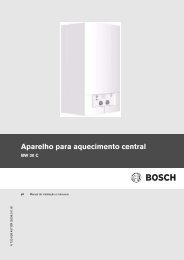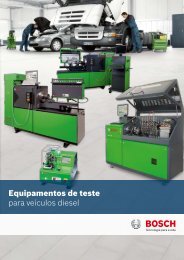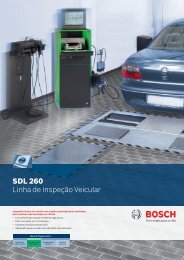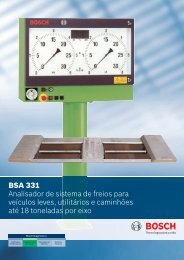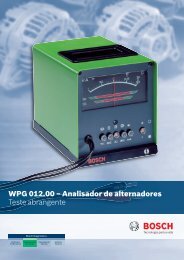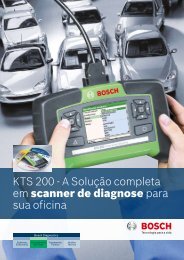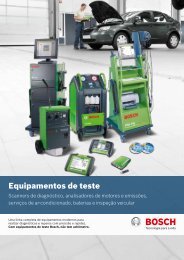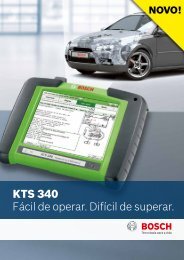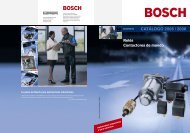Bosch Automotive A product history
Bosch Automotive A product history - Bosch worldwide
Bosch Automotive A product history - Bosch worldwide
- No tags were found...
Create successful ePaper yourself
Turn your PDF publications into a flip-book with our unique Google optimized e-Paper software.
36 | Supplement 2 | Journal of <strong>Bosch</strong> History<br />
Left to right:<br />
A look inside the engine<br />
compartment of an Audi<br />
100 TDI (1989). This<br />
model was the first diesel<br />
car in large-scale series<br />
<strong>product</strong>ion to feature<br />
high-pressure direct<br />
injection. As a result, the<br />
car reached a top speed<br />
of 195 kph, with an average<br />
fuel consumption of<br />
6 liters per 100 km.<br />
Common rail, the diesel<br />
system most frequently<br />
used today, was first<br />
installed in the Alfa<br />
Romeo 156 JTD (1997).<br />
It achieved uniform injection<br />
pressures of up to<br />
1,350 bar. This technology<br />
enabled multiple<br />
injections.<br />
A look inside the combustion<br />
chamber of a modern<br />
four-valve diesel engine<br />
(2008)<br />
in-line pumps from 1987. These ECU’s<br />
optimized emissions, noise, power, and<br />
consumption. Moreover, they enabled<br />
injection systems to be linked with other<br />
electronic systems, such as the traction<br />
control system (TCS), which stops the<br />
wheels spinning by intervening in engine<br />
management or in the brake control system.<br />
<strong>Bosch</strong> used this success to further extend<br />
its competence in both systems – in-line<br />
and distributor pumps. In the case of distributor<br />
pumps, collaboration with Audi<br />
resulted in the first systems capable of<br />
injecting fuel directly into the combustion<br />
chamber at a pressure of almost 1,000 bar.<br />
In combination with turbo-charging, this<br />
made the diesel engines built from 1989<br />
on more economical. The engines also<br />
produced less exhaust gas and helped<br />
vehicles achieve remarkable driving performance.<br />
High-pressure fuel injection<br />
marked the diesel engine’s breakthrough<br />
in Europe.<br />
Common rail and multiple injection<br />
The high proportion of passenger cars<br />
equipped with diesel engines – around<br />
30 percent in western Europe in 2000 –<br />
came about as a result of crucial further<br />
developments in high-pressure dieselinjection<br />
technology. <strong>Bosch</strong> offered a<br />
number of variants, including the radialpiston<br />
distributor pump (1996), the common-rail<br />
system (1997), and unit-injector<br />
technology (1998). They all achieved injection<br />
pressures of up to around 1,500 bar<br />
(and have even exceeded 2,200 bar in<br />
subsequent generations), and were thus<br />
characterized by both economy and performance.<br />
Eventually, the common-rail system won<br />
through. The Fiat subsidiary Elasis was<br />
responsible for the basic idea, but <strong>Bosch</strong><br />
refined the system to make it ready for<br />
series <strong>product</strong>ion. This system offered<br />
crucial advantages over the other two.<br />
Although the peak pressures of the common-rail<br />
system were lower than those<br />
of the unit-injector system (which could<br />
1986 1989 1993 1995 1996 1997<br />
EDC electronic diesel<br />
control system<br />
VP 37 axial-piston<br />
distributor pump<br />
for direct injection<br />
in passenger-car<br />
engines<br />
Control-sleeve fuel<br />
injection pump<br />
Unit-pump system<br />
(UPS)<br />
VP 44 radial-piston<br />
distributor pump<br />
Common-rail system<br />
for passenger-car<br />
engines



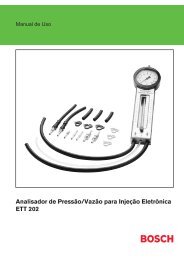

![Guia de instalação do ESI[tronic] Startcenter - Bosch](https://img.yumpu.com/53542449/1/190x135/guia-de-instalaaao-do-esitronic-startcenter-bosch.jpg?quality=85)
